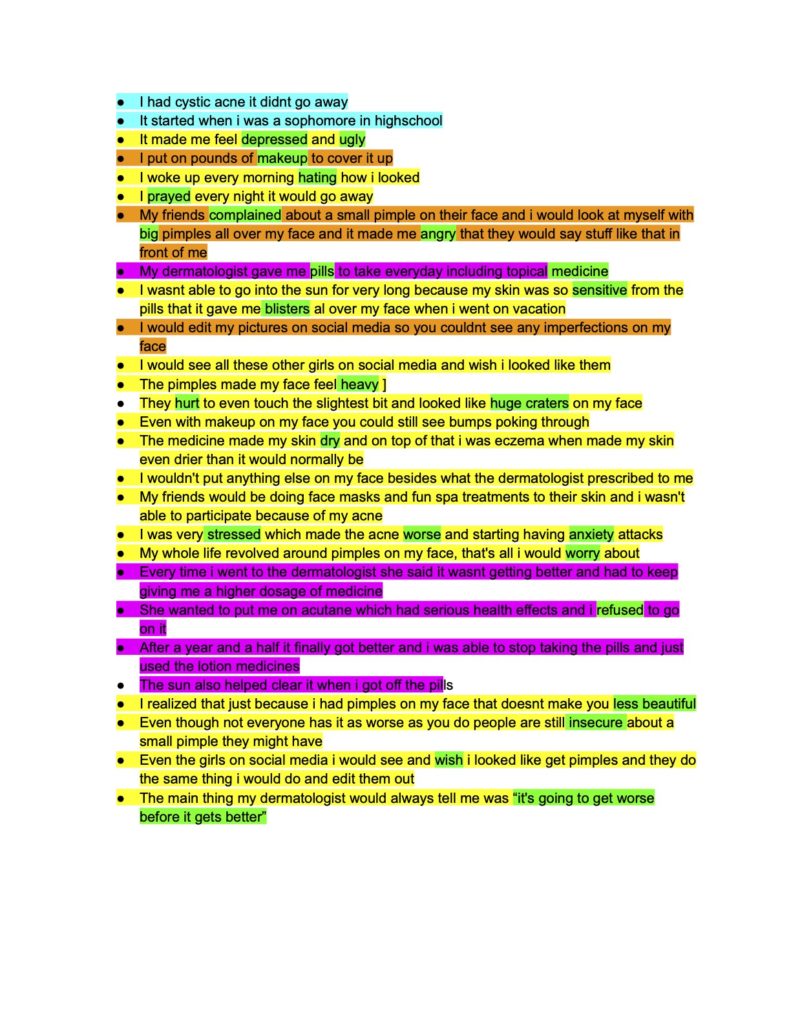We’ve all heard, “I’ve fallen, and I can’t get up.” How about, “I’ve got writer’s block, and I can’t get started.”
You’re stuck. You’re frustrated, sweating. Your tummy is in knots. Your heart is pounding. You’ve been staring at your blank screen for hours, and the deadline is looming.
You’re not the only one. As I dig into this blog, I am just coming out of a panicked state with all of the above symptoms. I can still hear my heart pounding, and my stomach is just beginning to settle down, even though I power walked two miles in 22-degree weather. I’m like many writers, both professional and amateur.
We’ve all heard the common tips to beat writer’s block: take a walk, get into nature, go back to bed and start tomorrow, take a shower (the place where all good ideas just come into our heads, right?).
What’s a sure-fire way to get out of Writer’s Block Hell?
The answer, my friends, is to do a brain dump, do the follow-up “group and order” process, create a preliminary outline (if the task calls for it), and then write a first draft.
This process works for book authors, business writers, and students, although some of the steps may differ. And this process works for me. So when I came back from my walk, I took a deep breath and did a brain dump.
What is a Brain Dump & How Does it Help Beat Writer’s Block?

Brain dumping is the process of recording your thoughts about a specific topic or aspect of a topic by writing them down on paper as they are occurring. You dump ideas from your head, down your throat, down and across your chest to your shoulder, and down your arm to your writing hand, which moves your trusty writing utensil across the page. You can also dump into a word document on a computer.
Why does this help so many beat writer’s block? Most writers get stalled when they are distracted, burned out, and hung up on writing perfectly. Brain dumping helps overcome this by giving you a route around whatever roadblock is jamming up your writing mojo. Brain dumping is like freestyling. It helps you get back in the flow—opening up and just letting the words escape onto the page.
There are hundreds of words and phrases used to describe this process, including “Random Thoughts,” “Musings,” and “Idea Jungle.” I prefer “brain dump” because it’s a somewhat humorous but frank translation of the process. My clients all seem to get a kick out of it, too.
How to Do a Brain Dump to Beat Writer’s Block

Each writer’s brain dump will look slightly different, as they work to develop a process that best suits their needs. But here’s a look at how I use my brain dump to beat writer’s block.
Step 1: Phase 1—General Dump
Start by gathering your tools.
- A writing utensil (pencil, pen—style and color don’t matter)
- Paper (legal pad, notebook paper, journal, unlined paper). You can also type on your keyboard in a word document.
- A timer (stopwatch, phone timer, sand timer—whatever makes you happy)
Write your topic or aspect of your topic at the top of the page.
Set your timer for five minutes.
Why just five minutes? It’s just enough time to knock off the cobwebs and dislodge any mental gears that are getting in the way of your words.
Get ready. Get set. Go!
Write down whatever comes to mind about your topic—words, phrases, sentences. Don’t stop to correct spelling or punctuation. Those mechanics don’t matter. And yes, this is your writing coach/teacher/editor saying this.
If you temporarily blank out, just jot down whatever comes to mind, like “I can’t think of anything.” “I’m so hungry.” “Is the five minutes over yet?”
Step 1: Phase 2—Detail Dump
Go through your general dump and highlight or circle key words/phrases with a marker. Create a new brain dump for each of these main ideas, repeating the steps from the general dump listed above. Write anything that relates to that word or phrase, repeating the process for all the key words/phrases that need a detail dump.
Step 2: Group Similar Ideas Together
Study each of your brain dumps, looking for ideas that can be grouped together. You can use different-colored highlighters, draw circles, arrows, or any other technique to create groups. If you’re inputting your brain dumps into a computer, you can highlight your idea choosing different colors to represent various aspects of a general idea. Develop a color-coding system unique to your project.
Create a new document, showing just the groups. What do you see? Are any important components missing? How can you fill in the gaps? Are all the groups equally important? Do any smaller groups need to be combined?
In this example, a student working on her college admissions essay did a brain dump to beat writer’s block. In her brainstorm about overcoming her severe case of acne and what she learned from the experience, she created a color-coding system to help group central themes together. She chose turquoise to indicate the discovery of the problem, yellow to show emotional responses, green to point to details about her treatment, magenta to indicate what she learned from the experiences, and orange to connect the experience to her projected major.

Step 3: Organize the groups into some kind of order—chronological, process, idea evolution

The order you choose will depend on the purpose, form, genre, and length of the writing you’re aiming for. Are you writing a book, a proposal, copy for a website, an essay for college admissions?
For example, if you are writing a book, your brain dump groupings may evolve into a table of contents, sections, and chapters. A proposal might include project goal, concept, plan, execution, and evaluation. Website content can consist of pages like Home, About Me, Services, Q and A’s, and Pricing. A student’s college essay answering a prompt on overcoming a challenge might describe the challenge, overcoming the challenge, lessons learned, and the relationship of those lessons to a planned major.
Guess what? Once you’ve completed your brain dump, you have also created a preliminary outline with details galore. Crisis averted! Writer’s Block—gone! Now you’re ready to craft a draft. Let’s get to it!
Want more writing tips like these? Subscribe to The Savvy Red Pen Blog! We also offer a full suite of editorial services. Contact us today to discover how we can help you!

